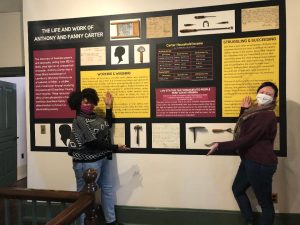By Lyra Bordelon
First emancipated from slavery, then working business owners and parents, having to fight in court to simply remain in their home, Anthony and Fanny Carter were members of the Greenbrier Valley community in the 1800s, before the 13th Amendment, before the Civil War, and before West Virginia itself. The couple is the subject of the newest exhibit from the Greenbrier Historical Society, located upstairs in the North House in Lewisburg.
“[Lewisburg locals Anthony and Fanny Carter] are emancipated in 1837, which is before the Civil War and almost 30 years before the 13th amendment was ratified,” said Greenbrier Historical Society Marketing Manager Brehana Scott. “Most people weren’t freed on a wide scale until 1865. So to be freed almost 30 years before that and be able to stay in the community that you were supposed to be expelled from is a huge undertaking for this couple. Of course they have a family, three young children, and they’re just trying to succeed, like most other people.”

Although previous exhibits mentioned Anthony Carter, such as the North House’s 200th Anniversary, the new exhibit began with Curator and Education Director Toni Ogden.
“We had [Anthony’s] ledgers and Toni … wanted to do research on him and dig into the ledgers,” Scott explained. “Transcribe them, figure out what this guy’s story is. This past year, she [was] reading it all and just got all this information.”
Scott arranged the exhibit based on new information – the result is the full, wall-sized exhibit greeting anyone who takes the stairs to the second story of the North House. Filled with information about the life, laws, work, and struggles of the Carters, the exhibit also shows off cobbling tools, such as hammers, tacks, leather, wax, and more, provided by Jim Costa. It also includes several pairs of leather shoes much like the ones Anthony would likely have worked on as a cobbler, a pre-fire map of downtown Lewisburg, foot forms, old clamps, and a workbench.
“Anthony Carter was a freed Black businessman of Lewisburg,” reads the exhibit. “We know Anthony as a husband, a father, a cobbler, and a landowner through studying his papers and Greenbrier County court records. These resources allow a rare glimpse into a free, working-class Black family’s determination to thrive in a slaveholding society.”
Afraid of rebellions and uprisings, state law required emancipated people to leave Virginia before 12 months passed, or “his or her right to freedom shall have accrued [and] he or she shall forfeit all such right, and may be apprehended and sold.” Despite this, Anthony and Fanny remained in Lewisburg, but his difficult and repeated battles in court to remain free could have gone a different way.
“Willis Lewis [was] a man that was enslaved here at the North House,” Scott said. “When he was emancipated, he actually asked a couple of years later to be re-enslaved, partially because of this law. He was forced to move to Ohio. His family and everyone he’s ever known is here, local. … ‘The devil I know is better than the devil I don’t.’”
 Printed on the exhibit are pages from the Carter family’s work ledger, showing who they were doing business with and at what prices. Scott and Historical Society Executive Director Nora Venezky both noted the importance of Carter’s ledgers in finding the names of enslaved individuals, and who owned them, for the North House 200th anniversary exhibit.
Printed on the exhibit are pages from the Carter family’s work ledger, showing who they were doing business with and at what prices. Scott and Historical Society Executive Director Nora Venezky both noted the importance of Carter’s ledgers in finding the names of enslaved individuals, and who owned them, for the North House 200th anniversary exhibit.
“He was mentioned in the North House 200 exhibit, which was way before any of this was thought of,” Scott said. “He made shoes for some of the families that lived here. … You can literally track every person and every enslaved person he made shoes for. It is a lot of both … he’s really doing a lot.”
Anthony’s cobbling business was not the couple’s only source of income – Fanny also ran a clothes washing business as the couple raised their three children. The complicated process of just washing clothes involved lugging the water about two blocks from the community well to their business, grating the soap, heating the water, dumping the kettle, lugging more water, beating clothes on the washboard, drying, starching, ironing, folding, delivering the clean clothes and more. One ledger page shows 256 pieces of clothing washed for $8.67.
Anthony passed away in 1844, with U.S. Census data showing Fanny living locally until 1860.
“This man literally works himself to death,” Scott said. “He’s taking on jobs that are probably too big for one person, he has some issues where some of the men who work under him have quit on him. He really is working hard to the last year of his life. Then he passes away. We keep track of Fanny for several years, she lives here locally and she keeps going. She’s a washing woman, which is hard work in of itself.”
Scott celebrated the creation of the impressive exhibit.
“This is such fun work,” Scott said. “It has its challenges, its stresses, its struggles, frustrations, anxieties, but when you see it [done], everything just washed away. Look at it.”
Scott also thanked Venezky for helping make the project work.
“She has been so supportive, so hands on, so helpful,” Scott said. “Of course I had all kinds of ideas but I didn’t know how to execute them. There are so many things and nuisances that you don’t understand … it’s great.”
The exhibit formally opens on Friday, February 5, and can be found upstairs in the North House Museum.



